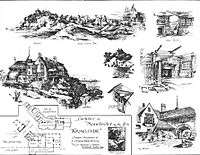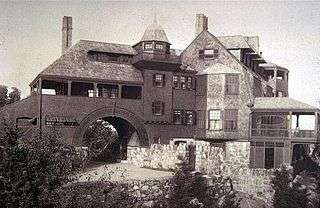Kragsyde
| Kragsyde | |
|---|---|
|
Kragsyde, from the south, ca. 1887. | |
| General information | |
| Type |
Summer cottage Shingle Style |
| Location |
Smith's Point Road Manchester-by-the-Sea, Massachusetts |
| Coordinates | 42°33′44″N 70°46′17″W / 42.562222°N 70.771444°WCoordinates: 42°33′44″N 70°46′17″W / 42.562222°N 70.771444°W |
| Completed | 1885 |
| Demolished | 1929 |
| Cost | $60,000 (1885) |
| Owner | George Nixon Black, Jr. |
| Technical details | |
| Floor count | 3.5 |
| Design and construction | |
| Architect |
Peabody & Stearns Frederick Law Olmsted (landscape design) |
| Main contractor | Roberts & Hoare |
Kragsyde (1883–85, demolished 1929) was a Shingle Style mansion designed by the Boston architectural firm of Peabody & Stearns and built at Manchester-by-the-Sea, Massachusetts. Although long demolished, it is considered an icon of American architecture.
History
It was commissioned by George Nixon Black, Jr. (1842–1928), heir to a Boston real estate fortune, who had been a Harvard classmate of architect Robert Swain Peabody. In 1882, Black paid $10,000 ($0.25 million today) for the 6 acre (2.4 ha) oceanfront plot on a peninsula called Smith's Point, overlooking Lobster Bay. Local contractor Roberts & Hoare built the house, 1883-85, for approximately $60,000 ($1.58 million today). Dramatically set upon a high rock outcropping, the rambling house was famous in its day and was published both in America and Europe. Black and his sister occupied it every summer from May to October until the end of their lives.[1]
Architectural historian Vincent Scully described Kragsyde as "a masterpiece," and stated that "Peabody & Stearns never again, to my knowledge, created a house of such quality." [2]
Design

Kragsyde's footprint was that of broad "V" – the three-and-a-half-story main house (75 x 45 ft / 22.9 x 13.7 m) facing the Atlantic Ocean, and a secondary wing (20 x 55 ft / 6.1 x 16.8 m) set at a 45-degree angle.[3] It was designed not only to maximize the views, but to capture the cool sea breezes. The house's most dramatic feature was a massive arch that formed a porte cochere and supported the loggia (open porch) and glass-enclosed billiard room above. Guests arriving by carriage would be dropped off under the arch, enter through the front door, and climb an interior stair to the main floor, which featured formal rooms for entertaining. Service rooms and the kitchen were located on the ground floor, and a service stair kept the servants out of sight. A dumbwaiter carried food from the kitchen to the butler's pantry on the main floor. A piazza (deck) the length of the house faced the ocean, and a covered section cantilevered out over the rocks. The parlor was surrounded on three sides by the piazza and an L-shaped covered porch. Stairs led down from the loggia to a series of terraces. The second floor contained bedrooms for the Blacks and their guests. The third floor contained bedrooms for servants.
The terraced landscape surrounding the house was designed by Frederick Law Olmsted. Some of his original walls survive.
Related houses

- "Cragside" (1863), a house in Northumberland, England designed by Richard Norman Shaw, cited as influencing the design of Kragsyde.[4]
- Kragsyde's carriage house (1882), also by Peabody & Stearns, stands at 29 Smith's Point Road.
- "Kragsyde II" (1982), a house based on the original (but a mirror image) was built on Swan's Island, near Bar Harbor, Maine.[5][6][7] Its location is 44°8′38.88″N 68°23′40.13″W / 44.1441333°N 68.3944806°W
- "Kragsyde" (2009), a contemporary house built upon the demolished mansion's foundations.[8] Like the original, it features a wing with porte cochere set at a 45-degree angle to the main house. VIDEO:
References
- ↑ http://www.woodlawnmuseum.com/Summer2006_web.pdf
- ↑ Scully, pp. 99-100.
- ↑ Sheldon, plate 39.
- ↑ Mark Girouard. "Introduction: The House and the Natural Landscape: A Prelude to Fallingwater". Fallingwater. By Edgar Kaufmann, Jr. Abbeville Press. ISBN 978-0-89659-662-7.
- ↑ Down East: At Home in Maine: Houses Designed to Fit the Land
- ↑ Down East:Kragsyde Reborn
- ↑ "Kragsyde," Old-House Interiors, August/September 2001.
- ↑ http://www.kragsyde.com
Sources
- The American Architect and Building News, March 7, 1885.
- Annie Robinson, Peabody & Stearns: Country Houses and Seaside Cottages (W.W. Norton, 2010).
- Vincent J. Scully Jr., The Shingle Style and the Stick Style: Architectural Theory and Design from Richardson to the Origins of Wright (New Haven: Yale University Press, 1955; reprinted 1971).
- George William Sheldon, Artists Country-Seats: Types of Recent American Villa and Cottage Architecture with Instances of Country Club-Houses, volume II (New York: D. Appleton and Co., 1887).
